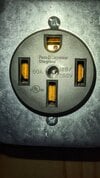ElectricNerd
Member
I’ve noticed issues like this crop up when I was using the 14-50 and tripping the breaker fixed them. I now have a TWC hardwired with a 60a breaker than has worked all of 30 minutes before shutting off due to the breaker itself getting to over 150 degrees. Electrician is waiting j a new 60a breaker to replace it, so I’m back to using the mobile charger on the 14-50 in the meantime. I cannot catch a break…A quick search:
Not charging! **FIXED**
One post says it's the connector under the rear seat being loose. Another just turned off the breaker at their panel and turned it back on and issue was gone. Some suggest a full reboot.



